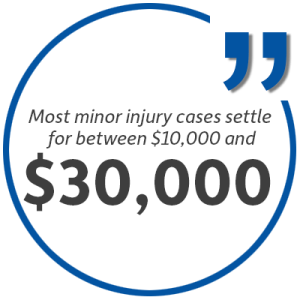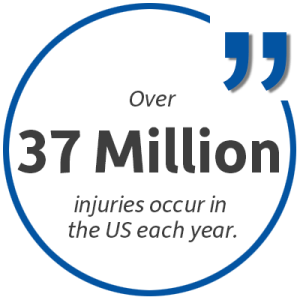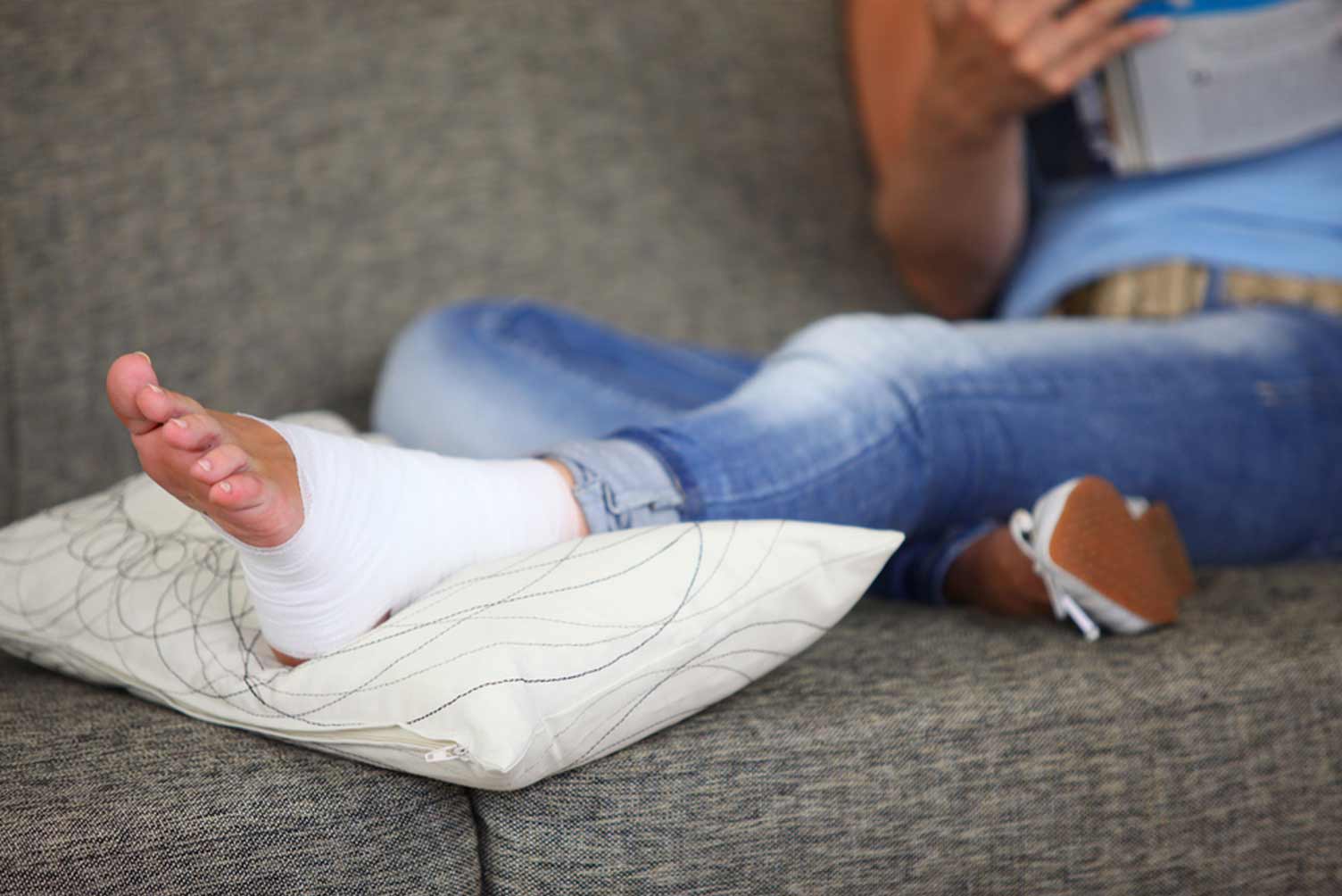Imagine Sarah, a young woman, making her way to her favorite coffee shop. As she strolls along the cobblestone pathway, her foot suddenly catches on a loose paving stone, causing her to slip and fall awkwardly.
With a sharp pain shooting through her ankle, Sarah struggles to regain her balance, realizing she has twisted and injured her ankle in the fall. Despite the picturesque surroundings, Sarah’s morning takes an unexpected turn as she grapples with the aftermath of her unexpected slip-and-fall accident.
Slip-and-fall accidents are unfortunately very common, with thousands occurring every day. These accidents can lead to a variety of injuries, from minor bruises and scrapes to more severe injuries like broken bones, traumatic brain injuries, and even death in extreme cases.
One of the most common injuries in slip-and-fall accidents is a sprained ankle. While not usually as severe as other ankle injuries, sprained ankles can still be very painful and disruptive to one’s daily life.
If you have suffered a sprained ankle from a slip-and-fall that was caused by another party’s negligence, you may be entitled to compensation through a settlement.
In this article, we’ll look at how slip-and-fall cases work, how to calculate a settlement for a sprained ankle and other ankle injuries, and how an experienced personal injury lawyer can help maximize your compensation.
How Slip-and-Fall Accident Cases Work

To receive compensation after a slip-and-fall accident, you must prove that another party was negligent and responsible for your injuries. Most often, slip-and-fall cases involve accidents that occur on someone else’s property, like a store, restaurant, apartment complex, etc. The property owner has a responsibility to keep their premises reasonably safe for visitors. If they fail to do so, they can be held liable through premises liability laws.
To build a strong slip-and-fall case, you must prove:
- The property owner created or knew about the hazardous condition that caused your fall
- They failed to properly repair the hazard or warn visitors about it
- Their negligence directly led to your fall and subsequent injuries
Examples of dangerous conditions that could lead to a premises liability slip-and-fall case include:
- Wet or slippery floors
- Uneven pavement or steps
- Poor lighting
- Cluttered walkways
- Lack of handrails on stairs
If you sprained your ankle in a slip-and-fall accident due to any dangerous conditions that the property owner failed to address, you may have a case.
An experienced personal injury lawyer can help investigate your accident, gather evidence, and build a compelling argument to prove negligence.
Factors That Determine Your Injury Settlement
If you are successful in proving negligence in your slip-and-fall case, you will then need to calculate damages to determine a settlement amount that covers your losses.
Some factors that influence settlement amounts include:
- Severity of the injury: More severe sprains that require surgery or extensive medical treatment will increase the average settlement value.
- Need for ongoing medical treatment: If you require physical therapy, follow-up doctor visits, or continuing medication, your settlement may be higher.
- Lost income: Any wages you lost due to missing work during your recovery are included in a settlement.
- Medical expenses: All costs associated with diagnosing and treating your ankle injuries are factored in.
- Pain and suffering: You can receive additional compensation for physical pain and emotional distress.
- Out-of-pocket costs: Medications, medical equipment, transportation to appointments, etc.
- Loss of enjoyment: Compensation for impact to your quality of life and ability to participate in activities.
- At-fault party’s insurance coverage: There may be limits on what insurance will pay out.
Your specific circumstances and losses will determine the total settlement value. More serious injuries with high costs and losses typically result in larger settlements, while less severe cases have lower settlements.
Average Settlement Amounts for Ankle Injuries

It’s difficult to pinpoint an exact average settlement for ankle injuries from a slip-and-fall, as each case has unique factors. However, most minor injury cases settle for between $10,000 and $30,000. Moderate sprains requiring some surgery may receive $30,000 to $75,000. Significant injuries sustained requiring extensive medical treatment could receive well over $100,000 in some personal injury cases.
Talk to your ankle injury attorney about what settlement range you can realistically expect based on the details of your accident and losses.
Don’t accept an early lowball offer from an insurance company before you know the full value of your claim.
Why You Need an Experienced Slip-and-Fall Injury Lawyer

Ankle injuries might seem like relatively minor injuries, but even they can have complications and long-lasting effects if not properly treated. Dealing directly with insurance companies can be difficult, as they will seek to minimize costs and may try to deny or reduce your claim. Having a knowledgeable slip-and-fall injury lawyer on your side levels the playing field.
A slip-and-fall injury lawyer will handle all aspects of your slip-and-fall case while you focus on recovery. They will conduct a thorough investigation, identify all liable parties, gather supporting evidence, calculate damages, negotiate aggressively on your behalf, and take the slip-and-fall lawsuit to court if needed.
Their experience with slip-and-fall cases gives them strategic negotiation skills to maximize your settlement. With strong legal representation, you are more likely to recover full and fair compensation without the stress of handling it all yourself.
Don’t leave money on the table or let insurance companies take advantage of you. Contact a reputable slip-and-fall injury law firm as soon as possible after your slip-and-fall accident to protect your right to compensation. They can provide personalized guidance for getting the maximum settlement you deserve.
The Dangers of Slip-and-Fall Accidents

According to the National Safety Council (NSC), over 37 million fall injuries occur in the US each year. Slip-and-fall accidents are one of the most common causes of these fall injuries. The combination of slippery surfaces, uneven ground, poor lighting, and cluttered areas frequently lead to a slip-and-fall incident in homes, businesses, and public spaces.
While some minor injuries may result, slip-and-fall accidents can also cause severe injuries.
Some potential injuries include:
- Sprains and strains: Ankles and wrists are particularly susceptible.
- Bone fractures: Broken hips, wrists, legs, arms, and ankles are common.
- Traumatic brain injury: Head trauma from the impact can cause concussions or worse.
- Spinal cord injuries: Damage to the neck and back can lead to paralysis.
- Death: In extreme cases, falls can be fatal due to head trauma or organ damage.
In addition to physical harm, slip-and-fall accident victims are often left with exorbitant medical bills, lost income, pain and suffering, and reduced mobility. Holding a negligent property owner accountable is crucial.
How Fault Is Determined in Slip-and-Fall Accident Cases
To receive compensation for your slip-and-fall injuries and damages, you must prove that your accident occurred due to another party’s negligence and failure to provide safe premises. This falls under premises liability law.
The general criteria for proving fault in slip-and-fall claims include:
- Dangerous condition: There must be proof of an unsafe condition like a wet floor, poor lighting, defective stairs, etc.
- Notice: It must be shown that the property owner knew or reasonably should have known about the hazardous condition but failed to take corrective action. This is often the most contested part of slip-and-fall cases.
- Causation: Evidence must demonstrate that the hazardous condition directly caused the victim’s fall and subsequent injuries.
- Damages: Medical bills, lost wages, pain and suffering resulting from the victim’s injuries must be calculable and provable.
- Liability limits: If slip-and-fall accidents occur on a commercial property, the owner’s insurance liability limits can come into play.
Securing the evidence necessary to prove each of these criteria requires experience. A seasoned slip-and-fall attorney knows how to thoroughly investigate an accident scene, obtain witness statements, prove notice standards were not met, and demonstrate how your injuries relate to the slip-and-fall incident. Having a skilled lawyer in your corner levels the playing field against big insurance companies.
Why Prompt Medical Care Is Crucial After a Fall
It’s understandable to feel shaken up and disoriented after suffering a slip-and-fall. However, it is vital that you seek medical treatment following any kind of fall accident, even if you don’t think you sustained serious injuries.
Here’s why:
- Adrenaline can mask debilitating injuries like fractures of the ankle bones, traumatic brain injury, organ damage, soft tissue injuries, or internal bleeding. Seeing a doctor quickly can catch other injuries before they worsen.
- Medical documentation from the earliest care establishes a record of injuries that insurance companies can’t dispute later in your personal injury case.
- Delaying medical treatment gives insurance companies reason to doubt accident-relatedness of late-arising symptoms.
- Quick care demonstrates you were proactive about mitigating damages and preventing catastrophic injury.
- Waiting to get checked out can negatively impact your recovery outlook.
After your initial emergency room visit or urgent care check, follow all doctor recommendations for medications, diagnostic tests, specialists, physical therapy, and follow-ups. Non-compliance with your medical care recommendations will also jeopardize your ankle injury claim and your ability to seek compensation down the road.
Watch Out for Insurance Company Tactics
Insurance companies aren’t necessarily malicious, but they are for-profit businesses. Their primary obligation is to their shareholders, not to accident victims.
They will use tactics to pay as little on personal injury claims as possible.
Some things to watch out for include:
- Quick settlement offers: They want to settle before full damages are calculable.
- Lowball offers: They make unreasonably low opening offers hoping you’ll accept.
- Denials: They might deny a slip-and-fall claim due to pre-existing conditions, lack of maintenance records, or other technicalities.
- Delays: Drawing the process out tires claimants.
- Surveillance: Insurance investigators may covertly watch to see if you exaggerate injuries.
Having experienced slip-and-fall attorneys on your side prepares you for delays, denials, and other insurance company antics. Your lawyers will tenaciously negotiate to get you the maximum recovery possible.
The Challenges of Proving Constructive Notice
As mentioned, a critical component is proving a property owner’s negligence. By showing that the property owner had reasonable “notice” of the dangerous condition that caused the fall, you can pursue maximum compensation.
This notice can be either actual or constructive. Actual notice means they directly created the hazard or observed it themselves. Proving actual notice is relatively straightforward with eyewitnesses or recordings, for example.
Constructive notice is more difficult to establish. This refers to reasonable proof that the hazard existed long enough that the owner should have discovered and remedied it. The longer the hazard existed, the greater the likelihood that the owner had constructive notice of it.
Some factors in proving constructive notice include:
- High-traffic area: Hazards in busy zones should be spotted sooner.
- Previous incidents: Other falls in the same area signal an ongoing issue.
- Poor maintenance: Insufficient inspection and upkeep make hazards likely.
- Obvious hazard: Large spills should not go unnoticed for long.
Even with these considerations, proving constructive notice often comes down to reasonable timeframes, which are subjective. An experienced slip-and-fall lawyer knows how to build the strongest argument possible to convince adjusters, judges, and juries that notice requirements were breached.
Overcoming Contributory Negligence Defenses
In a small minority of states, any negligence by the victim in causing their own accident can bar them from compensation. However, most states like Indiana follow modified comparative negligence rules. Under this model, you can still recover damages if you are no more than 50% at fault. Above 50%, and your slip-and-fall claim is barred.
How much you can recover also depends on your percentage of fault. If found 25% negligent, your final slip-and-fall settlement would be reduced by 25%, for example. Property owners will look for any minor carelessness on your part to reduce liability.
Some contributory negligence arguments they may make include:
- You weren’t paying attention to your surroundings.
- You knew about the hazard but proceeded anyway.
- You continued using an area despite warning signs.
- You were wearing improper footwear for conditions.
- You were under the influence of drugs or alcohol.
Skilled personal injury attorneys expect these arguments. They thoroughly investigate slip-and-fall accident scenes and aggressively refute unreasonable allegations of comparative negligence made by insurance companies during slip-and-fall lawsuits.
Don’t let bogus defenses cost you the compensation you deserve.
Establishing Damages in Your Slip-and-Fall Accident Claim
Assuming liability is proven, the next step is calculating damages – the monetary costs of the victim’s injuries and losses.
Economic damages personal injury lawyers may seek compensation for after a severe injury in a personal injury claim include:
- Past and future medical expenses and care
- Rehabilitation and physical therapy for sustained injuries
- Medical equipment and modifications
- Lost wages from missed work time
- Reduced earning capacity
- Pain and suffering
- Emotional distress
- Loss of enjoyment and activities
- Permanent disability or disfigurement
Quantifying these damages requires pulling together sufficient evidence and documentation. Your lawyer will gather medical bills and records, employment records, receipts and bills, and other proof to justify the compensation being sought in negotiations or court.
Seeking Maximum Settlements in Slip-and-Fall Death Cases
In the most severe cases, slip-and-fall accidents result in fatalities. When an accident leads to a wrongful death due to negligence, the financial consequences for the victim’s family can be devastating.
Some damages the family may claim include:
- Medical bills and funeral expenses
- Loss of current and future income
- Loss of benefits like health insurance
- Loss of household services the victim provided
- Loss of companionship and guidance
- Pain and suffering of family members
Money can never replace a lost loved one. However, holding negligent parties fully accountable can provide some financial stability for grieving families. Experienced personal injury lawyers aggressively pursue maximum settlements and verdicts in fatal slip-and-fall cases.
Trust Your Slip-and-Fall Accident Case with Crossen Law Firm
If you have suffered significant injuries in a slip-and-fall accident, it is in your best interest to discuss your slip-and-fall lawsuit with the qualified personal injury attorneys at Crossen Law Firm as soon as possible. Trying to handle accident claims alone can jeopardize your right to fair compensation.
Our knowledgeable lawyers bring a wealth of experience in the legal process to the table during your slip-and-fall case, including:
- Investigation techniques to secure necessary evidence
- Strategies to prove fault and defeat liability defenses
- Understanding of insurance policies and practices
- Medical knowledge to show the causation between accidents and injuries
- Familiarity with contributory vs comparative negligence
- Proficiency in calculating and proving various damages
- Negotiation and litigation skills to maximize your slip-and-fall settlement
- Dedication and compassion for injury victims
Don’t leave money on the table or take unnecessary risks handling your slip-and-fall case alone. Trust our results. We recently secured a $315,000 settlement in a premises liability case for our client. Let us secure maximum compensation for you, too.
Our seasoned personal injury team at Crossen Law Firm is here to help accident victims recover damages. Contact us for a free consultation about your case today.

 317-401-8626
317-401-8626 
.jpg)